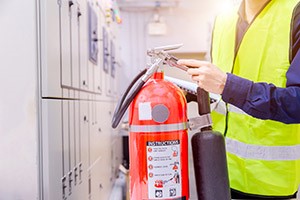Know Your Fire Extinguishers

When used properly, portable fire extinguishers can save lives. Did you know not all fire extinguishers are the alike? There are three ratings for fire extinguishers, and each rating indicates which type of fire the extinguisher should be used for.
- Class A – Trash, Wood, Paper: Fire extinguishers with a Class A rating are effective against fires involving paper, wood, textiles, and plastics. The primary chemical used to fight these fires is monoammonium phosphate.
- Class B – Liquids: Fire extinguishers with a Class B rating are effective against flammable liquid fires. These can be fires where cooking liquids, oil, gasoline, kerosene, or paint have become ignited. Two commonly used chemicals are effective in fighting these types of fires. Monoammonium phosphate effectively smothers the fire, while sodium bicarbonate induces a chemical reaction which extinguishes the fire.
- Class C – Electrical Equipment: Fire extinguishers with a Class C rating are suitable for fires in “live” electrical equipment. Both monoammonium phosphate and sodium bicarbonate are commonly used to fight this type of fire because of their nonconductive properties.
All fire extinguishers must be approved by a nationally recognized testing laboratory to verify compliance with applicable standards.
When operating a fire extinguisher, it is important to remember the word PASS.
- Pull the pin – Hold the extinguisher with the nozzle pointing away from you, and release the locking mechanism
- Aim low – Point the extinguisher at the base of the fire
- Squeeze the lever slowly and evenly
- Sweep the nozzle from side-to-side
Along with properly using a fire extinguisher, it’s crucial to develop an emergency escape plan. With the right plan in place and the proper knowledge of fire extinguishers, everyone has a better chance at staying safe in the event of a fire.


